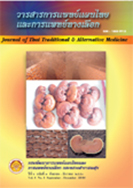Postprandial Hyperglycemic Control Activity of Morus alba L. Leaf Extract
Main Article Content
Abstract
Diabetes mellitus is a chronic disease and serious public health problem. It is a major risk factor for cardiovascular and renal diseases and remains a serious cause of morbidity and mortality. Traditional doctors in various countries use the leaves of Morus alba L. or white mulberry to treat diabetes mellitus. Currently, it has been reported that Morus alba L. leaf extract could inhibit human and rat intestinal disaccharidase. In this study, the water extract (MA-W), 50% ethanolic extract (MA-AE), 95% ethanolic extract (MAE) and MA-E fractions [the water-soluble fraction (MAE-F1) and ethanol-soluble fraction (MAE-F2)] were tested for postprandial hyperglycemic control activity in normal and alloxan-diabetic rats, compared with chlorpropamide or acabose as a positive control. Orally given MA-W, MA-AE and MA-E could improve the oral sucrose tolerance of normoglycemic and alloxan-diabetic rats. All extracts exhibited excellent activity at 0.5 and 1 hour after sucrose administration and MA-E showed the highest activity. On the other hand, these extracts showed no significant effect on the ability to tolerate an external glucose load. A study on postprandial hyperglycemic control action of the MA-E fractions showed that orally given MAE-F1 exhibited significant effects on the oral sucrose tolerance of normoglycemic and alloxan-diabetic rats. MAE-F1 at doses of 100 mg/kg and 200 mg/kg demonstrated postprandial blood sugar control activity approximately equal to that of acabose at the dose of 4 mg/kg in normal and alloxan-diabetic rats, respectively. However, MAE-F2 did not have any significant effects on the oral sucrose tolerance of normoglycemic rats. In addition, preliminary chemical screening of fraction MAE-F1 showed that it was composed of glycosides and flavonoids. In conclusion, these results indicated that Morus alba L. extracts could improve oral sucrose tolerance in normal and alloxan-diabetic rats, with the mechanism of action apparently being similar to acabose, which acts by inhibiting enzyme disaccaridase. The chemical composition of the active fraction comprised glycosides and flavonoids.
Article Details
References
2. Leiter LA, Ceriello A, Davidson JA, Hanefeld M, Monnier L, Owens DR, et al. Postprandial Glucoe Regulation: New Data and New Implications. Clin Therap 2005;27 (Suppl. B): S42-56.
3. Shah S, Iqbal M, Karam J, Salifu M, McFarlane SI. Oxidative stress, glucose metabolism, and the prevention of type 2 diabetes: pathophysiological insights. Antioxid Redox Signal 2007;9:911-29.
4. ก่องกานดา ชยามฤต, ลีนา ผู้พัฒนพงษ์ สมุนไพรไทย ตอนที่ ๗: หม่อน. กรุงเทพฯ: บริษัทประชาชน จำกัด; ๒๕๔๕. หน้า ๒๕๐.
5. Rios JL, Recio MC, Villar A. Antimicrobial activity of selected plants employed in the Spanish Mediterranean area. J Ethnopharmacol 1987;21:139-52.
6. Ramirez VR, Mostacero LJ, Garcia AE, Mejia CF, Pelaez PF, et al. Vegetales empleados en medicina tradicional Norperuana [abstract]. Peru: Banco Agrario del Nacl Univ trujillo; 1988.
7. Tucakov J. Ethnophytotherapy of diabetes [abstract]. SRP ARH CELOK LEK 1978;106:159-73.
8. Lemus I, Garcia R, Delvillar E, Knop G. Hypoglycemic activity of four plants used in Chilean popular medicine. Phytother Res 1999;13(2):91-4.
9. Sharaf A, Mansour MY. Pharmacological studies of the leaves of Morus alba, with special reference to its hypoglycemic activity. PlantaMed 1964;12:71-6.
10. Bwititi P, Musabayane CT. The effects of plant extracts on plasma glucose levels in rats. Acta Med Biol 1997;45(4):167-9.
11. Arzi A, Zahedi S, Ghanavati J. Effect of Morus alba leaf extract on streptozotocin-induced diabetes in mice [abstract]. Ahvas J Med Sci 2001;30:62.
12. Chen F, Nakashima N, Kimura I, Kimura M. Hypoglycemic activity and mechanisms of extracts from mulberry leaves (folium mori) and cortex mori radicis in streptozotocin-induced diabetic mice. Yakugaku Zasshi 1995;115:476-82.
13. Andallu B, Varadacharyulu NCh. Control of hyperglycemia and retardation of cataract by mulberry (Morus indica L.) leaves in streptozotocin diabetic rats [abstract]. Indian J Exp Biol 2002;40:791-5.
14. Kojima Y, Tonegawa E, Taniguchi K, Narasaki R, Hasumi K. Ratardation of the development of diabetes mellitus in a murine model of type 1 diabetes (NOD mouse) fed Morus alba leaves [abstract]. J Jpn Soc Nutr Food Sci 2001;54:361-4.
15. Andallu B, Suryakantham V, Srikanthi BL, Kesava Reddy G. Effect of mulberry (Morus alba L.) therapy on plasma and erythrocyte membrane lipids in patients with type 2 diabetes. Clinica Chimica Acta 2001;314:47-53.
16. Litthilert P. Effect of mulberry (Morus alba Linn.) leaves extracts on plasma glucose level in streptozotocin-induced diabetic rats. A thesis for the degree of Master of Science in Biopharmaceutical Sciences, Faculty of Pharmacy, Bangkok: Mahidol University; 2001.
17. Oku T, Yamada M, Nakamura M, Sadamori N, Nakamura S. Inhibitory effects of extractives from leaves of Morus alba on human and rat small intestinal disaccharidase activity. Br T Nutrition 2006;95:933-8.
18. Trinder P. Determination of blood glucose using 4-amino phenazone as oxygen acceptor. J Clin Pathol 1969a;22:246.
19. Trinder P. Determination of blood glucose using an oxidase-peroxidase system with a non-carcinogenic chromogen. J Clin Pathol 1969b;22:158-61.


